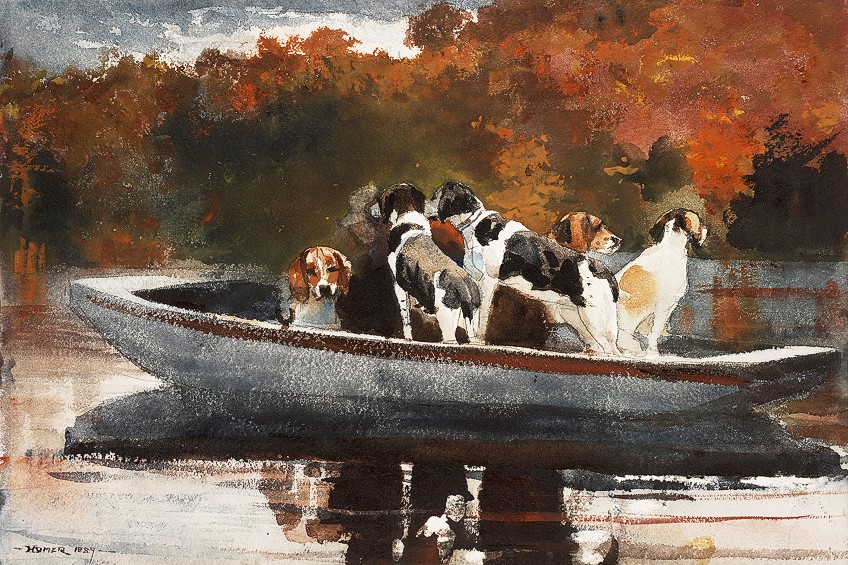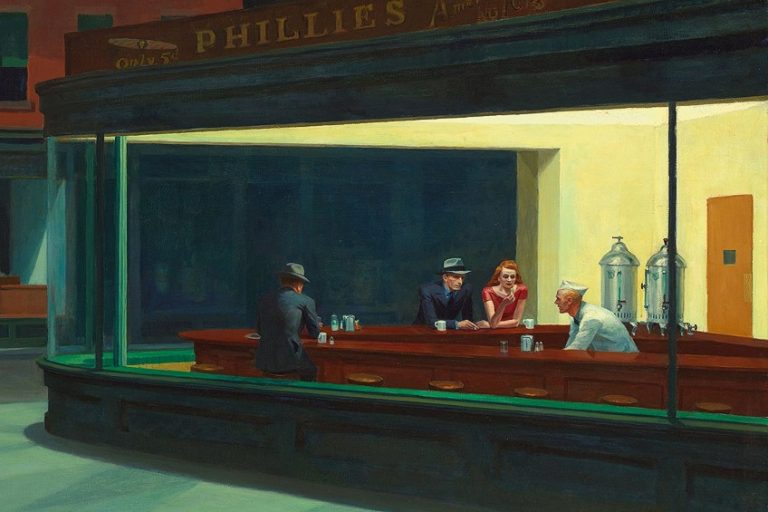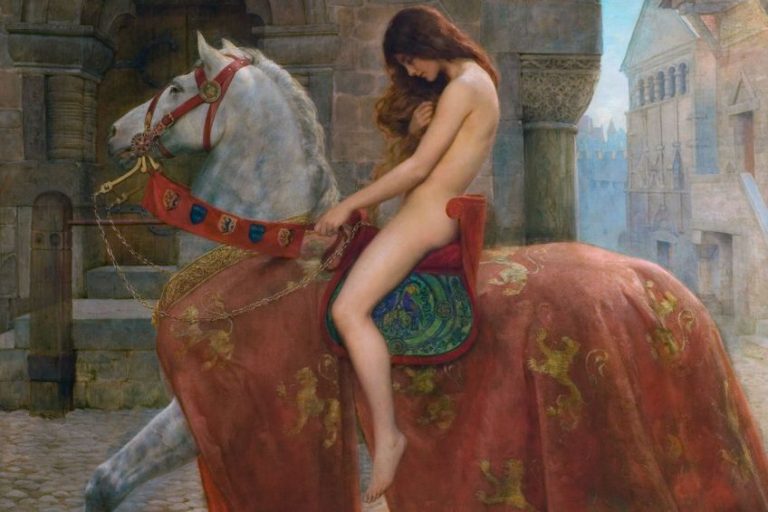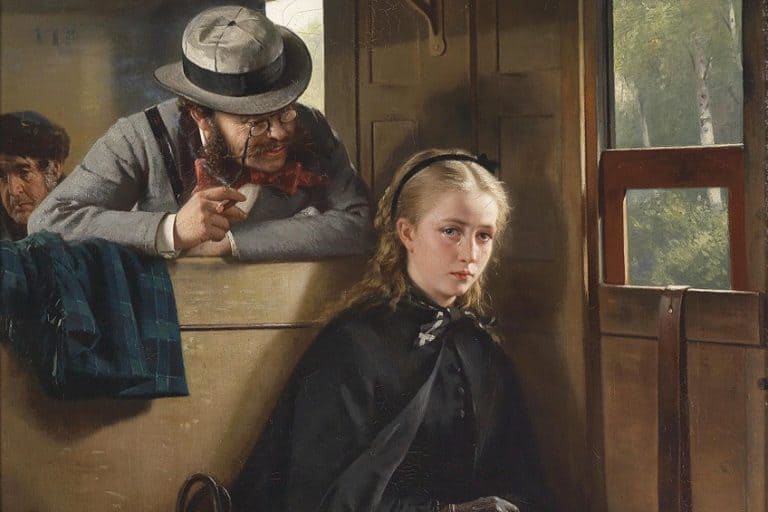Famous Paintings of Animals – A Look at Animals in Art
The depiction of animals in art goes as far back as the first cave paintings made by primitive humans. From around the 17th century onward, famous animal artists have portrayed scenes of domestic life and domestic animals, as well as hunting, and wildlife scenes. As the study of the natural world started to blossom in the 18th century, so did the number of animal paintings by famous artists. Today, we will be exploring a select few of these famous paintings of animals.
Table of Contents
- 1 Our Favorite Famous Paintings of Animals
- 1.1 The Rhinoceros (1515) by Albrecht Dürer
- 1.2 The Goldfinch (1654) by Carel Fabritius
- 1.3 Peacock, Hen, and Male Pheasant in a Landscape (c. 1750s) by Tobias Stranover
- 1.4 The Kongouro from New Holland (1772) by George Stubbs
- 1.5 The Monarch of the Glen (1851) by Edwin Landseer
- 1.6 The Horse Fair (1852) by Rosa Bonheur
- 1.7 Hunting Dogs in a Boat (1889) by Winslow Homer
- 1.8 The Bachelor Party (1896) by Louis Wain
- 1.9 A Friend in Need (1903) by C. M. Coolidge
- 1.10 Bull (1911) by Franz Marc
- 1.11 Head of a Dog (1930) by Edvard Munch
- 2 Frequently Asked Questions
Our Favorite Famous Paintings of Animals
Animals were represented as an essential part of the aristocracy’s daily activities in 19th-century Victorian salons. From the 20th century onwards, contemporary art unified all prior techniques for depicting animals in art – animals retained both metaphorical and descriptive elements while also being regarded as equally essential beings.
Some animal paintings by famous artists were created without the artist ever having seen the animal at all, and their appearance was produced purely from the descriptions of travelers from other lands.
The Rhinoceros (1515) by Albrecht Dürer
| Artist | Albrecht Dürer (1471 – 1528) |
| Date Created | 1515 |
| Medium | Woodcut |
| Current Location | National Gallery of Art, Washington, United States |
Albrecht Dürer’s woodcut of an Indian rhinoceros has been in print ever since its first publication in 1515. Over more than a hundred years, eight versions of the image were produced from the original woodblock; the copy at the National Gallery of Art in Washington is one of a vast number created in the 16th century, following Dürer’s death. Many artists adopted it as a template for their renderings of the animal during the next 200 years.
The writing at the top of the woodcut indicates that the animal depicted belongs to King Manuel I, which was transferred from Goa to Portugal.

The rhino was brought as a tribute to the Pope by the Portuguese king, but it died when the boat it was traveling in sank halfway. For many years, the rhinoceros was the first of its species to appear in Europe, causing quite a stir. The artist did not observe the animal in person but seems to have based his remarkably realistic representation on descriptions and illustrations of the creature that arrived in Nuremberg.
The British Museum houses his preliminary artwork for the woodblock, which features his personal handwritten description.
The Goldfinch (1654) by Carel Fabritius
| Artist | Carel Fabritius (1622 – 1654) |
| Date Created | 1654 |
| Medium | Oil on canvas |
| Current Location | Mauritshuis, Den Haag, Netherlands |
Carel Fabritius was regarded as one of the most renowned 17th-century Dutch painters. He was among the artists who contributed to the period that became known as The Dutch Golden Age by art historians and critics. Fabritius painted still lifes with a variety of animals, the majority of which were birds. The Goldfinch is one of his most renowned masterpieces.
It was completed in 1654 and has long been admired for the artist’s exquisite color blending to achieve the many various shades of golden-yellow from which the goldfinch gets its name.

The goldfinch is a popular seed-eating bird found in North Africa, Europe, and Western and Central Asia. It had been domesticated by humans for at least 2,000 years. A colorful bird with a charming song, it was believed to bring good luck and good health. This artwork was fairly uncommon for the painting style that comprised The Dutch Golden Age. The painting was executed on a wooden panel that had been missing for more than 200 years before resurfacing in Brussels.
It was later repaired in 2003 and is still considered one of the most significant historical artworks from the time period.
During restoration, it was discovered that the painting’s surface had several tiny dents that had developed while the pigment was still wet, as there was no splitting. A novel was published by Donna Tartt based on the painting in 2013, titled The Goldfinch, as well as a movie of the same name in 2019.
Peacock, Hen, and Male Pheasant in a Landscape (c. 1750s) by Tobias Stranover
| Artist | Tobias Stranover (1684 – 1756) |
| Date Created | c. 1750s |
| Medium | Oil on canvas |
| Current Location | Private collection |
Tobias Stranover, who was born in modern-day Romania, became a well-traveled and skilled painter by the time he was in his 20s. He was regarded as an artist who had a great fondness for animals, particularly birds of various kinds.
Stranover is reported to have studied under legendary bird artist Melchior d’Hondecoeter, as well as others who were likewise captivated by these birds’ diverse plumage.
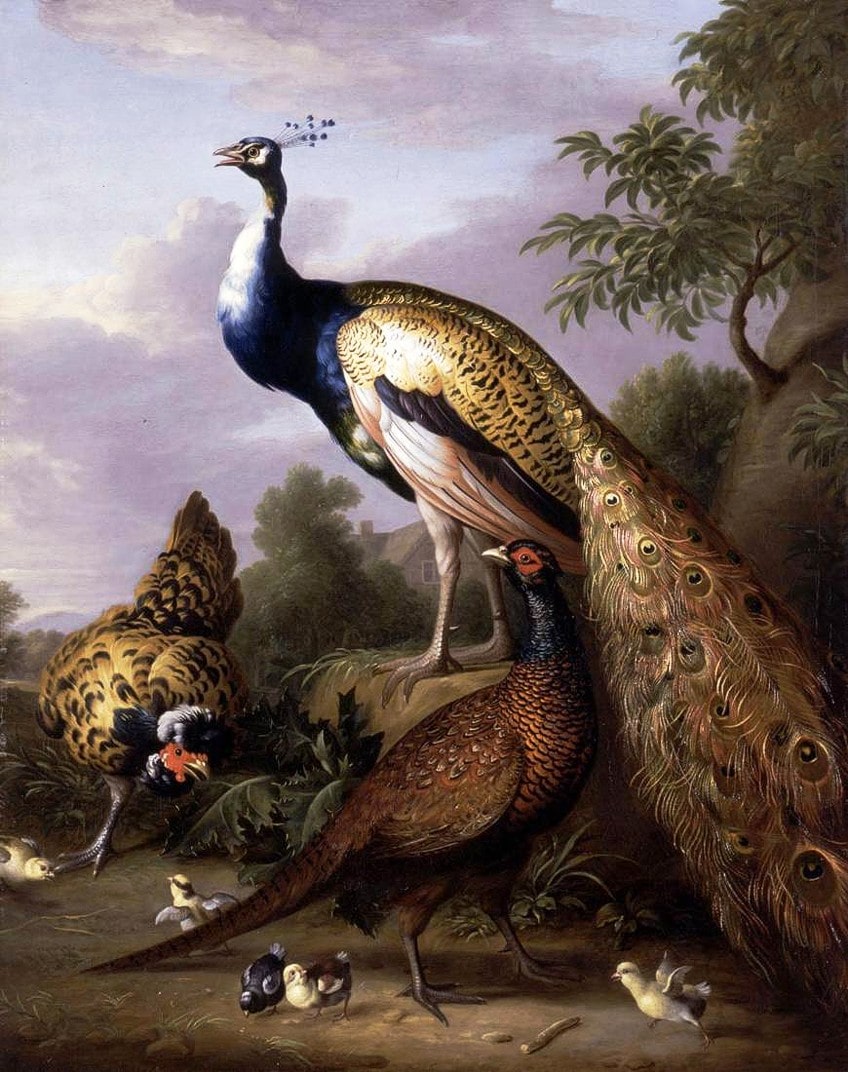
This particular piece was a figurative recreation of a small animal exhibition that included such magnificent birds as peacocks and other animals that were associated with riches and high status. Stranover rose to prominence for his paintings, which frequently included a flock of birds placed in ways that highlighted some of their most striking colors and feathers in the sunshine.
His painting technique inspired a lesser movement during the Baroque period in which artists focused only on bird images where the birds were arranged in an unnatural fashion.
The Kongouro from New Holland (1772) by George Stubbs
| Artist | George Stubbs (1724 – 1806) |
| Date Created | 1772 |
| Medium | Oil on canvas |
| Current Location | National Maritime Museum, London, United Kingdom |
This painting of a kangaroo by George Stubbs is the earliest depiction of an Australian species in Western artwork. Joseph Banks commissioned the painting, which was modeled on the inflated skin of a kangaroo he had obtained off Australia’s east coast during James Cook’s first journey of exploration in 1770. It also appears to be influenced by Sydney Parkinson’s kangaroo drawing; Sydney Parkinson had been Joseph Banks’ botanical artist on James Cook’s first trip.
It shows the animal resting on a rock, gazing over its shoulder, against a backdrop of mountains and trees.

Another of his artworks, Portrait of a Large Dog (1772), also depicted an Australian animal – the dingo. Neither of these artworks was based on live animal subjects though. The Society of Artists in London initially displayed both pieces in 1773. Subsequent exhibits took place at Liverpool’s Walker Art Gallery and London’s Whitechapel Art Gallery. In recent years, the artwork has also been on display at Parham House in Sussex for public exhibitions.
The Department of Culture denied an application to bring them to Australia because of their national significance.
Sir David Attenborough, who spearheaded the drive to keep both paintings in the UK, said it was “wonderful news that these two illustrations, so essential in the history of zoological discoveries, were to stay in the country where they had been commissioned and produced.”
The Monarch of the Glen (1851) by Edwin Landseer
| Artist | Edwin Landseer (1802 – 1873) |
| Date Created | 1851 |
| Medium | Oil on canvas |
| Current Location | Scottish National Gallery, Edinburgh, Scotland |
In European culture, stags and other antlered animals have long been used to represent nobility or grandeur. The red stag, which is endemic to Scotland’s highlands and mountains, is one of the most stunning deer species on the globe.
Edwin Landseer created a painting that displays this magnificent creature in its natural splendor. It depicts the red stag as an emblem of honor and commitment.

Landseer was well-known for creating highly realistic depictions of nature and all species of animals, and this piece was widely regarded as one of his greatest. Being one of the most renowned artworks of the 19th century, it sold well as steel engraving replicas and was eventually purchased by businesses for use in advertising. Pears soap firm acquired the picture in 1916 and used it in their advertisements.
By the mid-20th century, the image had become somewhat of a cliché as “the definitive cookie tin icon of Scotland”.
The Horse Fair (1852) by Rosa Bonheur
| Artist | Rosa Bonheur (1822 – 1899) |
| Date Created | 1852 |
| Medium | Oil on canvas |
| Current Location | The National Gallery, London, United Kingdom |
Rosa Bonheur, a French painter, was one of the most prominent female artists of her period, and her paintings often depicted animals or natural surroundings in exquisite detail. She is known as one of the famous animal artists of the 19th century, with an unrivaled ability to portray pictures of animals in action. The Horse Fair was the title of one of Bonheur’s most famous paintings of animals.
This 1852 artwork depicts a procession of thoroughbred horses entering the fairgrounds in Paris, where it was commonplace to buy and trade horses during that era.
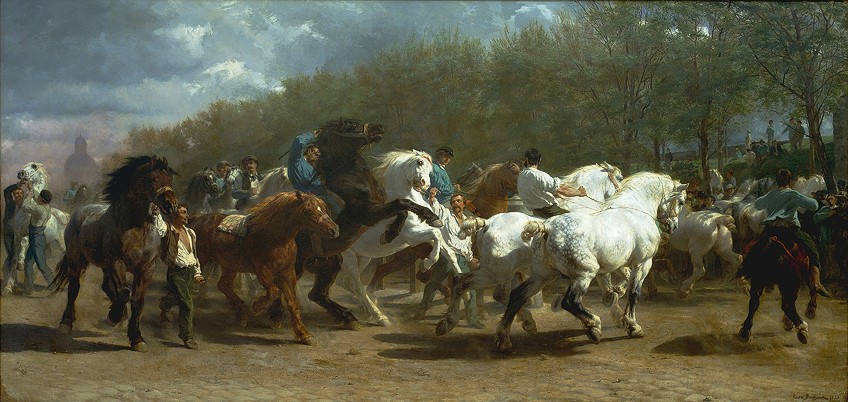
Bonheur’s artwork received worldwide recognition for her extraordinary ability to depict these animals in such a realistic manner. Their muscles can be seen rippling beneath their skin, and the light glints off the horses’ well-kept coats as they gallop past.
Bonheur created from a number of draft horse sketches she had created at the Parisian horse market on the tree-lined Boulevard near the hospital, which is apparent in the painting’s background.
Hunting Dogs in a Boat (1889) by Winslow Homer
| Artist | Winslow Homer (1836 – 1910) |
| Date Created | 1889 |
| Medium | Watercolor and graphite pencil |
| Current Location | Rhode Island School of Design Museum, Rhode Island, United States |
Winslow Homer was a well-known American artist of the 19th century. He was possibly most known for his marine-themed works, which frequently featured people living, enjoying, or working by the water’s edge or on the open sea.
One of his most famous pieces depicts a number of hunting dogs packed together in a little wooden boat as it sails over a lake, rather than people.
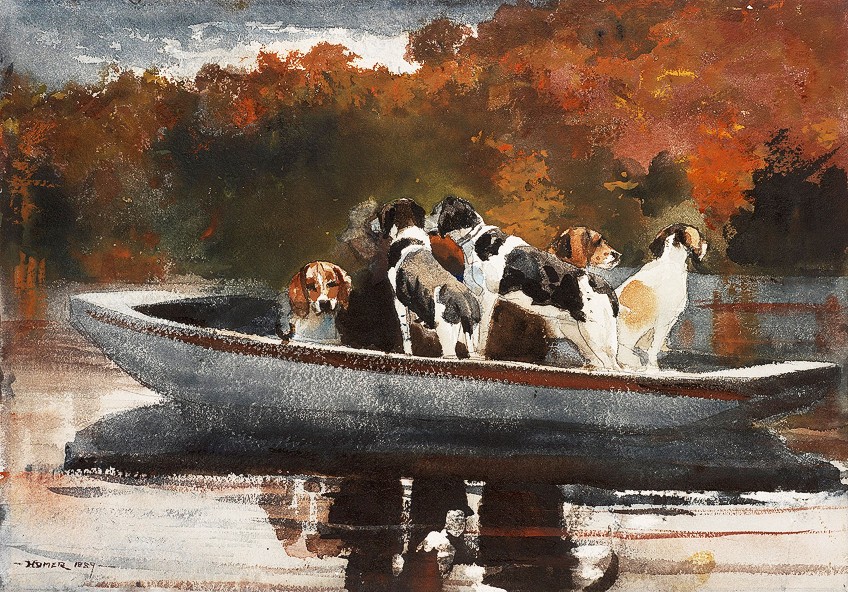
This painting is simply named Hunting Dogs in a Boat and was completed in 1889, during the height of Homer’s artistic career. This artwork is regarded as a brilliant portrayal of these hunting hounds since they are being led to a location where they would start a hunt.
The brilliant autumn leaves in the backdrop appear to imply that the dogs were ready for a hunt, as the autumn season is usually regarded as the hunting season in the United States for many various wild animal species.
The Bachelor Party (1896) by Louis Wain
| Artist | Louis Wain (1860 – 1939) |
| Date Created | 1896 |
| Medium | Oil on canvas |
| Current Location | The Penny Illustrated, Christmas Edition, 1896 |
Louis Wain was an established English illustrator who seems to have a particular fondness for cats. Wain’s passion for cats was expressed through his various drawings and cat canvases in a range of actual and imaginary scenarios. Wain’s most successful pieces contained a hilarious portrayal of cats engaging in various human-like situations.
“The Bachelor Party” is one such piece. It was created around 1939 and has since grown into a classic among cat lovers all around the planet.
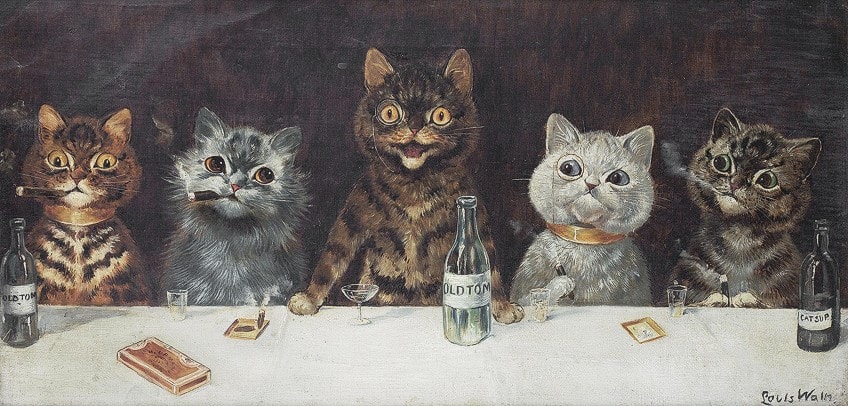
Wain was known to have struggled with serious mental illnesses, and some art critics and scholars even refer to some of his latter works as convincing indications that he was suffering from schizophrenia. Despite his continued mental issues, Wain’s painting The Bachelor Party was greatly appreciated for its amusing usage of tom cats sitting around a table enjoying beverages and cigarettes in the same ways a group of humans would.
The huge, bright eyes and expressions of the cats appear to lend as much fun to the work as any other feature.
A Friend in Need (1903) by C. M. Coolidge
| Artist | C. M. Coolidge (1844 – 1934) |
| Date Created | 1903 |
| Medium | Oil on canvas |
| Current Location | Multiple prints |
C.M. Coolidge, took the relationship between dog and man to the next level with his series of anthropomorphic dogs playing poker. One of his most renowned works in the collection, A Friend in Need, is an ageless artwork permanently engraved into traditional American society and is more usually found as replicas in billiard rooms instead of being examined in fine art museums.
Coolidge produced the oil painting in 1903 for the marketing firm Brown & Bigelow, who eventually used it as a cover for countless advertising mailings.

Coolidge, on the other hand, is frequently confined to the pages of history, despite his considerable contribution to both the creative and economic communities. Coolidge, best known as the creator of those wooden board paintings commonly found at carnivals where visitors poke their heads through to be photographed, known as Comic Foregrounds, also established a bank, launched his town’s first newspaper, and wrote an opera.
Coolidge’s dog paintings, on the other hand, immediately became one of his most well-known contributions to American culture due to their distinct anthropomorphic rendering.
Bull (1911) by Franz Marc
| Artist | Franz Marc (1880-1916) |
| Date Created | 1911 |
| Medium | Oil on canvas |
| Current Location | Solomon R. Guggenheim Museum, New York City, United States |
Franz Marc, a significant figure in the early 20th-century Expressionist movement, depicted a wide range of themes, including women in flowing clothing and wheat sheaves, and even weasels. Marc was trained by von Deiz and von Hackl, artists accomplished in the Naturalist style of the period.
Only after finishing his schooling and traveling to France did Marc’s art start to evolve into the Expressionist style that made him renowned.
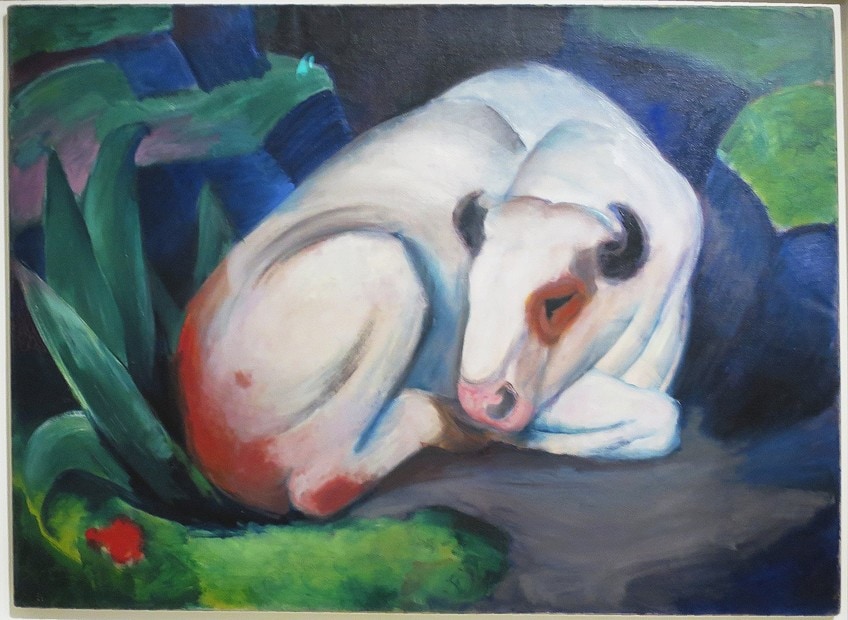
Along with Kandinsky, he co-founded Der Blaue Reiter, a group that embraced abstract forms, bright colors, and symbolism as a means of dealing with the excesses of contemporary life, a mood heightened by the impending outbreak of WWI. This atmosphere of anxiousness is purposely lacking in several of Marc’s works, including Bull. In reality, the tranquility that this image transmits is amazing, especially given its subject – an animal that is typically represented in all its muscle-rippling grandeur.
A sleeping bull, almost cat-like in its curled-up stance and striking in its tenderness, is depicted.
Head of a Dog (1930) by Edvard Munch
| Artist | Edvard Munch (1863 – 1944) |
| Date Created | 1930 |
| Medium | Oil on canvas |
| Current Location | Munch Museum, Oslo, Norway |
Edvard Munch was a prominent Norwegian painter who created some outstanding works throughout his career. Munch formed a deep bond with his pets after withdrawing from society in his final years. He was having anxiety attacks at the time because his sister had died in 1908.
In fact, he took these dogs everywhere, even the local movie theater. If they barked during a movie, he’d take it as a sign that the movie was no good and leave right away.
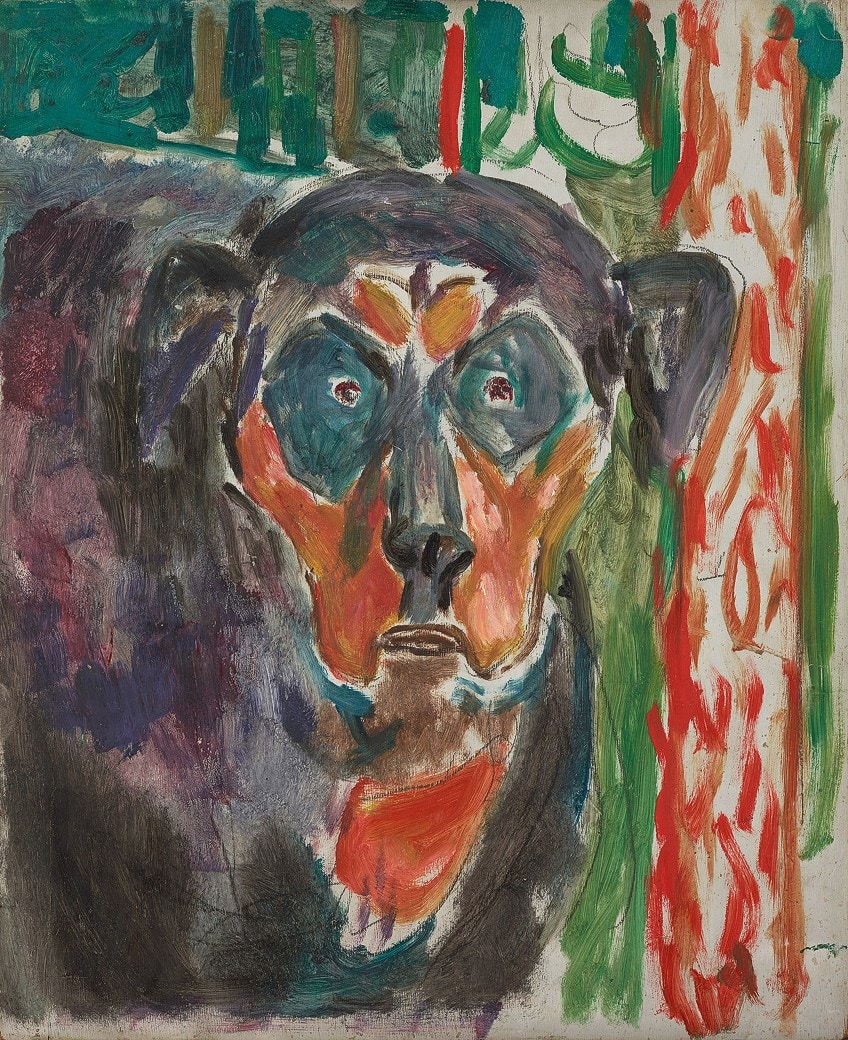
His passion for dogs inspired the development of this and other artworks, such as a painting that featured two dogs portrayed in the Expressionist style, known as Large and Small Dog (1921). The most dominant colors in the image are black and green with certain areas accentuated with orange hues.
That wraps up our list of animal paintings by famous artists that have been produced through the centuries. These portrayals of animals in art continue to delight audiences right up to the present day. We can thank animal artists for their love of animals and a keen eye for nature that resulted in their beautiful animal artworks.
Frequently Asked Questions
Are There Any Animal Paintings by Famous Artists?
Yes, there are many animal paintings by famous artists. The depiction of animals in art has been a popular subject for millennia. Some of the famous paintings of animals were produced by artists such as Albrecht Dürer, Edvard Munch, Franz Marc, Louis Wain, and many more.
How Long Have Humans Been Painting Animals in Art?
If we go back to the first cave art, we can see that the portrayal of animals in art is as old as the art itself! This makes sense since animals have been around far longer than we have. We have always relied on animals for sustenance, sport, and company, so it is no surprise that they would feature in our art too.
Isabella studied at the University of Cape Town in South Africa and graduated with a Bachelor of Arts majoring in English Literature & Language and Psychology. Throughout her undergraduate years, she took Art History as an additional subject and absolutely loved it. Building on from her art history knowledge that began in high school, art has always been a particular area of fascination for her. From learning about artworks previously unknown to her, or sharpening her existing understanding of specific works, the ability to continue learning within this interesting sphere excites her greatly.
Her focal points of interest in art history encompass profiling specific artists and art movements, as it is these areas where she is able to really dig deep into the rich narrative of the art world. Additionally, she particularly enjoys exploring the different artistic styles of the 20th century, as well as the important impact that female artists have had on the development of art history.
Learn more about Isabella Meyer and the Art in Context Team.
Cite this Article
Isabella, Meyer, “Famous Paintings of Animals – A Look at Animals in Art.” Art in Context. October 26, 2022. URL: https://artincontext.org/famous-paintings-of-animals/
Meyer, I. (2022, 26 October). Famous Paintings of Animals – A Look at Animals in Art. Art in Context. https://artincontext.org/famous-paintings-of-animals/
Meyer, Isabella. “Famous Paintings of Animals – A Look at Animals in Art.” Art in Context, October 26, 2022. https://artincontext.org/famous-paintings-of-animals/.


